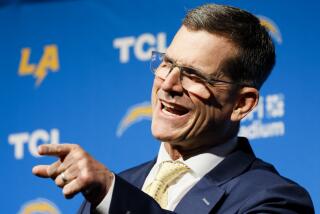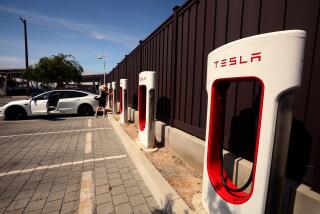Supercharged Second Wind : Engine Accessory Breathes New Life Into Firm Bogged Down by Slow Sales
Six summers ago, Jim Davis, president of B&M; Automotive Products in Chatsworth, settled into the driver’s seat of a 1970 Chevrolet Chevelle and stomped on the gas pedal. Under the hood was a supercharger, a pump that forces extra air into the engine and can boost the horsepower by 40% to 60%.
He still remembers the exhilarating speed and raw power. “The first thing that impressed me was that when you just barely touched the throttle, you could literally feel the horsepower,” said Davis, 54.
At the time, B&M; needed some extra oomph. The 30-year-old company had carved a successful niche by selling sophisticated automatic transmission kits that helped turn ordinary sedans into weekend drag-racers, but plenty of competitors had sprung up during the last decade, and B&M;’s sales were stuck in neutral.
Davis, a former record-holding drag-racer and advertising executive, needed to rev up B&M;’s sales, and the supercharger did just that. The privately owned company started selling its supercharger in late 1983. Since then, the company’s total annual sales have more than doubled, and last year superchargers accounted for 18% of B&M;’s $16.5 million in sales.
In all, B&M; has sold about 12,000 of the units, which retail from $1,200 to $2,000 each.
“I would never have predicted the size of the initial sales,” said Pat Ganahl, editor of Rod and Custom Magazine. “It was astronomical--totally unheard of in this industry. The total number of superchargers sold previous to that would be probably in the hundreds.”
B&M; has “the best-selling supercharger,” said Marlan Davis, technical editor of Hot Rod Magazine. “B&M; has gone through the trouble of engineering different kits for different cars.”
B&M; is not the only manufacturer of superchargers, nor are B&M;’s models the most high-tech on the market. But B&M;’s superchargers are overwhelmingly the most popular, and they have been designed to fit on a wide variety of models, including various Chevrolet, Ford, Buick, Chrysler and Toyota engines.
Before Californians rush out to buy superchargers, they should know that B&M;’s superchargers are not legal for street use on any American cars made after 1965 because they have not been granted exemptions from emission control laws by the state Air Resources Board.
Still, this doesn’t deter the hard-core enthusiasts who buy them, promising that they will be used off-road, and then put them on street cars. “We don’t advocate it,” B&M;’s Davis said. He said B&M; plans to obtain Air Resources Board exemptions for an upcoming supercharger that will fit late-model cars and work with factory fuel-injection systems.
B&M;’s success boils down to a new application of a technology that was established in the 1920s. Superchargers were used on such vintage luxury cars as Cords and Duesenburgs, but the technology all but disappeared in the 1960s when Detroit found that it was easier to attain comparable power by simply making bigger engines.
Superchargers, or blowers, as they are also known, are the under-the-hood equivalents of the blow dryer. Installed on top of the intake manifold where the engine “breathes” and linked to the crankshaft by pulleys and belts, the supercharger rams more air into an engine.
The result can be dramatic. Adding a B&M; supercharger to a factory-stock, 180-horsepower Camaro engine would boost its horsepower to 250 and trim the time that it takes to cover a quarter-mile by about 1.3 seconds, according to George Wallace, B&M;’s director of engineering.
There are two markets for superchargers: drivers between 19 and 45 years old who want their cars and trucks to look impressive under the hood and go faster, and those who need the added power to haul big loads, such as tradesmen and recreational-vehicle owners.
One reason for B&M;’s success is that it came up with a compact supercharger. For years, modified truck superchargers have been used to propel professional 2,500-horsepower drag-racing cars. But it was rare for a car on the street to have one, and it was necessary to cut a hole in the hood for the supercharger to fit. B&M;’s superchargers, however, nestle comfortably underneath many hoods, affording drivers extra power without drawing unwanted attention from police.
B&M;’s superchargers come with 30 pages of detailed installation and maintenance instructions. Somebody who doesn’t know how to change a spark plug isn’t going to want to tackle the installation, but a mechanic can do the job for about $700.
The supercharger’s lure, of course, is speed. Robert Bartholomew, a 47-year-old welder from Minnesota, installed a B&M; supercharger on his 1979 Chevrolet show car last spring. He spent 2 1/2 hours bolting the supercharger onto the Camaro’s 400-cubic-inch engine.
“After I put the blower on, it was unimaginable,” Bartholomew said. He once got the supercharged Camaro up to 150 m.p.h. before he backed off because the handling got so dicey, he said.
Turbocharging, a technology similar to superchargers, has become a popular, factory-installed option on everything from $9,000 Chevrolet Sprints to $75,000 Porsches. Turbos have small propeller-like compressor wheels driven by the exhaust flow that forces additional air into the engine.
But there is concern about the reliability of turbos. The turbos’ turbines spin at up to 120,000 r.p.m. and can generate temperatures of 350 degrees.
B&M; had investigated making turbochargers, but Davis was underwhelmed. “The biggest drawback is that turbochargers work at higher r.p.m. and the reality is that 90% of the time, you’re driving at under 3,000” r.p.m., he said.
B&M; discussed selling an existing supercharger made by another company. But “our chief engineer said we could build our own at half the cost and they would be twice as good,” Davis said. So B&M; came up with its own design.
For all of its merits, a supercharger can tax an engine because owners tend to drive the cars harder. The supercharger’s Achilles heel is detonation, or “pinging,” and a proper tuneup is a must.
Although superchargers have boosted B&M;’s sales, two-thirds--or $11 million--of its sales last year stemmed from various automatic transmission products: torque converters, shifters and shift kits. Davis figures that B&M; has 90% of the market for automatic transmissions sold in the United States to the so-called “aftermarket,” made up of car buffs who tinker with their cars.
The company’s hottest-selling automatic transmission shifter retails for about $170. Called the Megashifter, it’s popular because it looks and works like the more traditional “four-on-the-floor” shifter found on manual transmissions. For the weekend drag-racer, the Megashifter and other top-line B&M; shifters enable a racer to shift gears manually for optimum acceleration. Last year, B&M; sold $5.9 million worth of shifters, Davis said.
B&M;’s ties to drag-racing are nearly as old as the company. B&M; was started in Van Nuys in 1953 as an auto-repair garage by Bob Spar and Mort Shulman. Spar’s brother, Don, bought out Shulman’s share shortly thereafter. B&M; evolved into a transmission specialty shop after the Spar brothers began winning races with their Oldsmobile, which had a four-speed automatic transmission that they modified and later put on the market.
The company kept growing, but by the 1970s, the Spars were investing nearly all of their time in a now-defunct motor-home company, and B&M;’s business suffered. In 1973, the brothers asked Davis, a former National Hot Rod Assn. record-holder who ran his own Detroit advertising agency, to run things.
Davis came up with snazzy names for the shifters and transmission kits, and rewrote B&M;’s instruction sheets to make them easier to understand. But his key move was shifting B&M;’s marketing focus from drag-racers to street enthusiasts. “For every drag-racer, there’s a thousand street freaks,” he said. And in 1987, the company expanded its product distribution to such major retail auto parts chains as Pep Boys and Chief.
“Jim brings a business approach to an industry that’s probably made up of guys who are not businessmen but are designers and racers and are hands-on guys,” said Richard Paul, an engineer and owner of Latham Supercharger Co.
Anytime Davis and B&M;’s executives want hands-on experience, they don’t have to go far. “This is the toy room,” Davis said with a smile as he opened the door to a spacious garage, just a few steps from his office.
Davis shows off his company’s newest project cars--a low-slung Chevrolet Camaro IROC-Z, a 1932 Ford roadster and a supercharged Ford Mustang that is being developed in conjunction with Ford Motorsport.
The secret to keeping B&M; rolling is a constant stream of new products, he said, and the company spends 3% of its sales on research and development. But Davis also relies on some seat-of-the-pants evaluation. He likes to take a car out and step on the gas.






